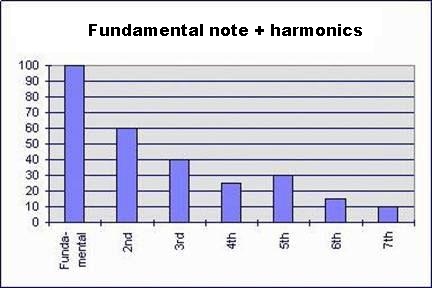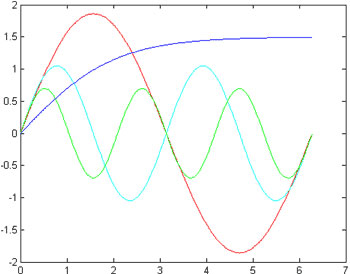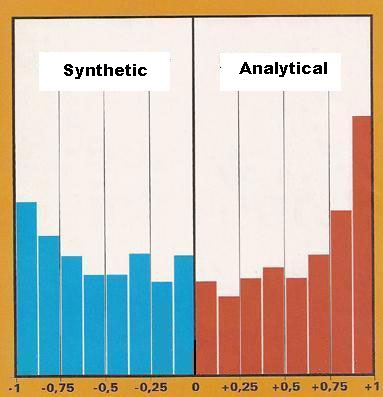SCIENCE DISCLOSES SURPRISING NEW ASPECTS ABOUT OUR
ABILITY TO HEAR.
Introduction
Why
have audio systems of good quality that present only small measurable
differences in the electro-electronic parameters been evaluated by the greater
public and yet received so many different assessments? Why has the same
audio
system been judged with such different opinions, some even antagonistic? Why
does the quarrel around the correct sound produce such excitement and heated
debates? What factors do we take into consideration when evaluating if a sound
is pleasant or not? Do we judge a sound by what we are accustomed to hearing?
According to international research, there have been impressive advances not
only in equipment and systems for sound evaluation, but also in understanding
how the human being perceives sound. These two fields of science, even though
very distinct, are intimately correlated as we will see in this article and in
the
articles that follow.
Reading some international magazines on this subject, I have assembled
interesting information and insights that I intend to present in this article.
We will talk a little bit about this new knowledge, expecting to contribute with
our Brazilian market, immobilized by its economic situation, and each time more
restricted to a smaller number of audiophiles and music lovers.
Let’s
begin with history from way back. In 1863, a book called "the Sensations created
by the Tones as a Psychological Base for the Musical Theory" of Herman Ludwig
Ferdinand Von Helmholtz (1821 the 1894) was published.
Helmholtz was a
physicist and a mathematician, born in Potsdam, Germany. He presented in his
book a study on the differences of the human perception of sounds and musical
tones. Through this study, the author raised the hypothesis of the probable
existence of two distinct groups of listeners: synthetic and the analytical ones.
At
that time, these findings of Helmholtz did not raise much fuss, due to some of
the acoustic devices that were presented in his same work, such as the famous
absorber that takes his name today, which was considered a great novelty at that
time. But since the
20th century, some universities have deepened the
studies on the human perception of sounds, initiated by Helmholtz.
In
the depths of the Department of Neurology of the University of Heidelberg,
Germany, Dr. Peter Schneider, of the Section of Bio-magnetism, with
scientists of the Universities of Liverpool and Southampton, in England, through
diverse auditory and physical medical experiments, managed to show that human
beings listen in different ways to the same sounds and tones. Today it is a
scientific fact that each individual perception of sounds and tones are
extremely differentiated.
This
new knowledge is leading to a revision of the concepts of sonorous electronic
equipment evaluation that we will talk about at another opportunity.
©
2004-2008 Jorge Bruno Fritz Knirsch
All rights reserved
http://www.byknirsch.com.br
Synthetic and the Analytical
Listeners
The
research of Dr. Peter Schneider confirmed the suspicion of the German
scientist Herman Von Helmholtz, who, more than a century ago, said that there
are two
distinct groups of people regarding auditory perception. He divided them as
the listeners of fundamentals and the listeners of the harmonic tones. In this
article, to simplify, we will call these two groups as Helmholtz originally
defined them in his famous book. The group of the synthetic listeners
synthesize the sound around its fundamental and the group of the analytical
listeners base their perception on the harmonics of the sound.
As
the research had shown, none of these two large groups hears better or worse
than the other one. It was found that the way one hears does not depend on sex,
race, profession, age or individuality. The research established that these two
groups simply hear in a different way one
from the other, as we will see
further on.
The
sound is formed by one fundamental and its harmonics, where the harmonics are
sine waves in multiple frequencies of the fundamental sine wave.

This graph is a
representation of a complex sound or complex waveform. A complex sound is the
sum of different sine waves. Any non-sinusoidal waveforms, such as square
waves or even the irregular sound waves made by human speech, can be represented
as a collection of sinusoidal waves of different amplitudes and frequencies blended
together. The technique of transforming a complex waveform into its sinusoidal
components is called Fourier analysis. Each column of the graph represents one
of the sine waves of the complex sound, each column, with two informations: the
frequency and, or the volume, or the sound intensity, or the voltage, or the
power, in percentage. The first column is called the fundamental of the sound
and is very important to define the pitch of the sound and all others sine
waves are the harmonics, which form, with there volumes
and frequencies the timbre of all different instruments, or human speech, or
other sounds. For example, the C4 note of a piano is a complex wave were the
fundamental is at 261Hz and there are multiples in higher frequecies,
which define the timbre of the piano. Each of us hear these complex sounds in a
different manner, according to the kind of listeners that we are: synthetics or analyticals.

The
group of the synthetics guide themselves based on the fundamental
frequencies of the sound, while the analyticals guide
themselves based on the harmonics
of the sound.
Not
too long ago, before these new findings, it was assumed that when a sound was
emitted without its fundamental tone (for example, the reproduction of a bass
sound in a speaker), the human
ear would have the capacity to reconstitute,
this fundamental missing, and thus, to listen to the entire specter of the
sound. However, new tests have demonstrated that only the synthetic listeners
have the capability to reconstitute the fundamental tone of a sound. The
analytical ones, as they base their hearing
on the harmonic tones, do not
reconstitute the fundamental tone.
Each
individual is classified as an analytical or synthetic listener according to a
specific scale design for this purpose. For the synthetics, the scale goes from
0 to -1. The "synthetics
-1" are the ones that are mostly oriented by the
fundamental. For the analyticals, the scale goes from 0 to +1, being that the
"analytical +1" are the ones that are mostly oriented by the harmonics of superior
order. Therefore, synthetics and analyticals meet only in the point 0 on the
scale. It is important to emphasize that each person can be classified at one
point of the scale from -1 to +1. In my case, for example, I am synthetic -0,2.
The people, in different positions in the scale, not necessarily hear better or
worse, but simply each one hears in a specific, different way. The musical
perception can be very differentiated. For example, there are people who can
hear the same sound up to four
octaves
higher than the others!
The
graph below presents the distribution of the people, in the -1 to +1 scale,
according to research done by the University of Heidelberg. Curiously, it
indicates that the majority of the people are
found in the extremities of the
scale. That means that a big part of the synthetic listeners are between -1 and
-0,5 and a great part of the analytical ones are between +0,5 and +1. These
findings can partially explain why we differ so much in the way we perceive the
sound of music, since most people are in the extremities of the scale.

These
facts have
been triggering new studies with very interesting discoveries
specially in relation to
the evaluation of
audio
equipment in the international media. Initially, the
Reviewers of
Critical
Listening (RCL) that judge the quality of the equipment for specialized foreign
magazines
have been
submitted to tests. It was disclosed that the best reviewers are the ones that
are
the synthetic and analytical people
found
closer to the center.
This finding made the audio international media
realize
the
need to carry-out
auditory tests on
RCL candidates. And from the results of those
tests, the magazines are now choosing which are the more appropriate people to be
the RCL, and so, part of the publishing body of the magazine.
But
the discoveries do not stop here! The University of Heidelberg, carried
out
examinations of nuclear espintomography of the human brain to show the anatomy
of the right and left cortex where the musical perception occurs. Also magnetoencefalography examinations had been carried
out to
determine electric currents in the right and left cortex
of the brain. The results are
surprising! They show that the
gray matter of the left cortex
(in the region responsible for hearing)
in the synthetic listeners is bigger than the
gray matter
of the right side. On the other hand,
the analytical listeners
have the right
side more
developed. The electric current
is
also greater
on the left side in the
synthetics, while,
in the analyticals,
it is
greater
on
the right side. Professional
musicians are also
classified as synthetic or analytical listeners. Even though they have more
cerebral mass in the hearing region of the brain than non-musicians,
the proportions also
differ depending on what type of listeners they are,
synthetic or analytical.
The
cortex of the left side, more developed in the synthetic
listeners, is very sensible
to fast impulses of sound, mainly those that do not exceed 50ms
(milliseconds) of duration. Rhythmic sounds are a preference of the synthetic
listeners,
while longer pulses are a preference of the analytical ones, whose right cortex
is
more
developed as we
have seen.
Therefore, longer sounds that are
more
melodic
are better perceived by the analyticals.
We can not forget that the
pitch
of
the frequency of the
perceived
sound can vary,
being around the
fundamentals
for synthetics,
and for the analytical ones being able to go
up to
four
octaves higher
than
the fundamental of the same sound.
These
differences are
evident and
they also explain the distinct preferences
for
musical instruments between the two
distinct groups. While the synthetic
listeners
prefer
the
instruments of percussion, guitar, piano, and
brass
instruments
such
as trumpets and transversal flutes,
the analytical ones prefer the
string
instruments
such as the
violas, the
bass, and brass
instruments and singing.
Differences between the
analytical and the
synthetic
listeners
have been perceived even in
the way they play instruments.
While the synthetic ones value the rhythm of music, the analytical ones value
the musical melody.
It is
interesting to notice that
because
there is a division of preferences
for
different instruments
between the two groups, we can also identify
if they are analytic or synthetic
by the localization
of the instruments inside of a modern orchestra. Thus,
those
of the left side of the
orchestra are normally the instruments
preferred by the synthetic
listeners, as for
example, the instruments of percussion, the piano,
and
the high violins.
It is curious,
and the research has also shown that the majority of the teachers belong to
the group of the synthetic
listeners. On the right side
of the orchestra, the side of the analytical
listeners,
are
instruments
such
as the
bass violin, the viola, violoncelo, the
double bass,
tuba, saxofone, the flute, the bassoon, oboé, and also the choral.
Therefore, as we can imagine,
the main differences are in the band of frequencies that go until 1.500Hz. (the
bass goes until 160Hz and the midband until 1.300Hz).
And
the discoveries
don't stop here. There is more!
Another study was carried out to
understand the preference for brands of equipment of electronic reproduction of music,
such
as speakers, record players,
CD-Players, integrated
amplifiers, receivers,
and
amplifiers,
between the two groups. This study revealed astonishing results. It
is almost incredible,
but there is
a
correlation between
brands
and types of audio
equipment
and the punctuation
given by
synthetic and analytical
listeners. Thus,
for example, a speaker of a certain
brand
is preferred more than other
speakers by
the synthetic
listeners
that have
a punctuation
on the scale
of
around -0.5.
Going further in the
investigation,
one found out that the
designers of that
same speaker, of that specific
brand
also belong to the same group,
or in other words,
to the
synthetic
-0.5 listeners.
Another example documented
that one integrated
amplifier of
a certain brand
was preferred
by
analytical listeners
of
+0.7. Further,
it was
verified that that equipment
was projected
by people also pertaining to the same group of listeners
as
the consumers
(+0.7). There
are,
therefore, different brands
of devices for the two
groups of listeners,
synthetics
and analyticals
and
all ranges.
These
discoveries will bring great changes in the marketing and the design of
audio
equipment
to such
an
extent
that we are
not able to
visualize
it
today.
Conclusion
We
have
presented
the most recent discoveries in the field of the human
musical perception. There are basically two types of listeners: the
synthetic and
analytical
ones.
They are two
distinct groups that hear simply
in a
different
way,
independent of the age, sex, color, etc.
The group of the synthetics guide themselves based on the fundamental
frequencies of the sound, while the analyticals guide themselves based on the
harmonics of the sound.
We
have shown
that according to statistical surveys, the majority of the synthetic ones and
the analytical ones are in the extremities of a scale,
and the reasons
for
this are
still unknown. We
have shown
that
there is evidence of
a correlation between the instruments chosen
by
the musicians and the group they belong
to
as listeners. Also, it was interesting
to notice that the division of the cerebral cortex, in analytical and the
synthetic
listeners,
corresponds with the division and rank of the instruments in a modern orchestra.
We
now
have
in front of us
new concepts of hearing that let us foresee significant changes
that are to come in the near future. With certainty, they will influence the design of the
equipment and also
the marketing of the companies of audio. On the other hand, the research has not
stopped here, it continues intensely. It is probable that our
personal
musical trends
are
already pre-programmed genetically
and studies in this direction are
on the way.
Today
we can
go
through tests and verify if we are synthetic or analytical
listener. Knowing this,
we
are able to
indicate which
brands and equipment
of audio
corresponds to
the preference of each
individual, or
even,
which ones we will find most pleasant.
This, without a doubt, has simplified the choices, and the purchase of the
equipment will
become
more objective. The assembly of an
audio
system with this
process is
made easy.
I ask, " What type
of listener are you?"
Back
 -
PRODUTOS, PROJETOS E INSTALAÇÕES
-
PRODUTOS, PROJETOS E INSTALAÇÕES